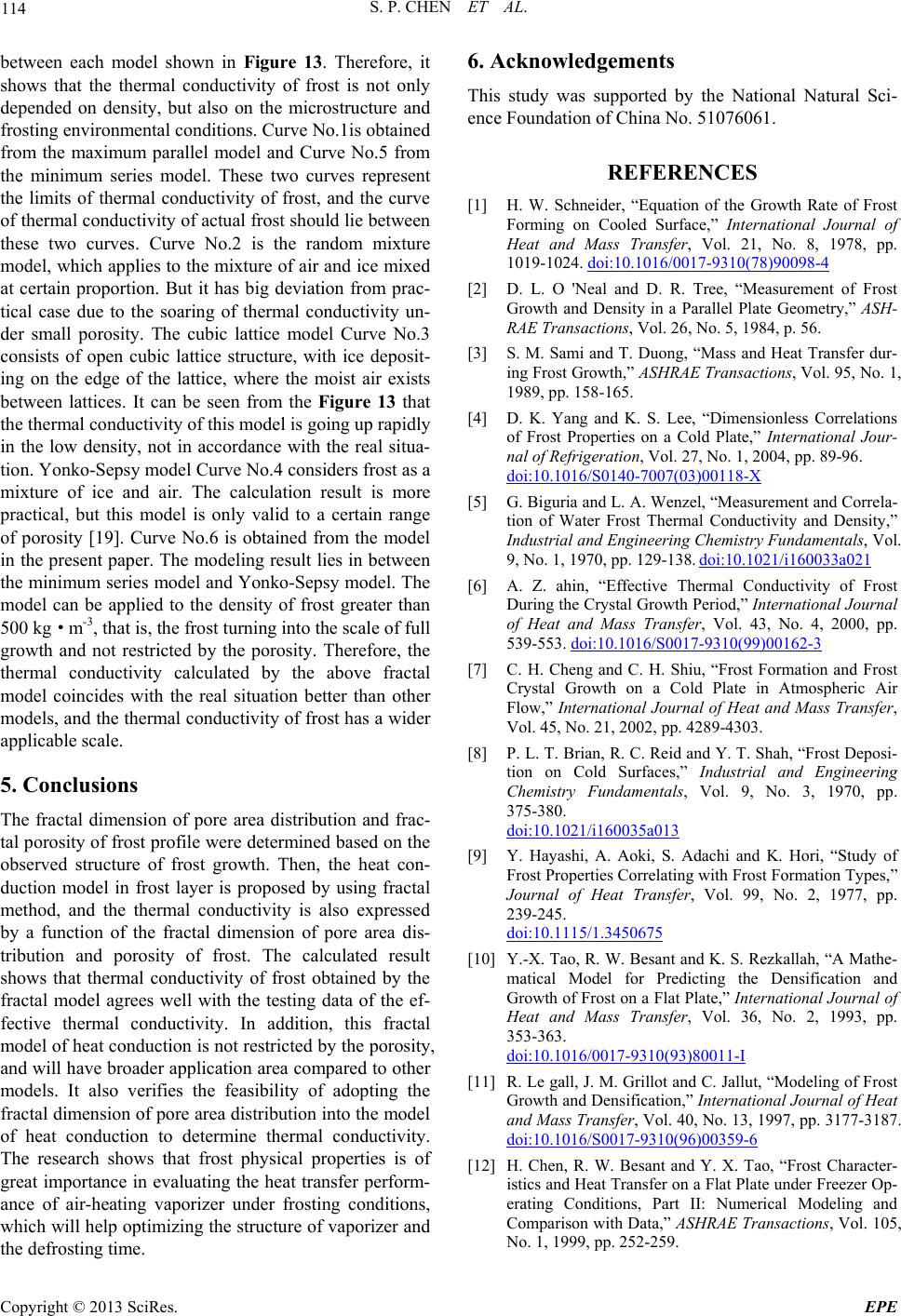
S. P. CHEN ET AL.
114
between each model shown in Figure 13. Therefore, it
shows that the thermal conductivity of frost is not only
depended on density, but also on the microstructure and
frosting environmental conditions. Curve No.1is obtained
from the maximum parallel model and Curve No.5 from
the minimum series model. These two curves represent
the limits of thermal conductivity of frost, and the curve
of thermal conductivity of actual frost should lie between
these two curves. Curve No.2 is the random mixture
model, which applies to the mixture of air and ice mixed
at certain proportion. But it has big deviation from prac-
tical case due to the soaring of thermal conductivity un-
der small porosity. The cubic lattice model Curve No.3
consists of open cubic lattice structure, with ice deposit-
ing on the edge of the lattice, where the moist air exists
between lattices. It can be seen from the Figure 13 that
the thermal conductivity of this model is going up rapidly
in the low density, not in accordance with the real situa-
tion. Yonko-Sepsy model Curve No.4 considers frost as a
mixture of ice and air. The calculation result is more
practical, but this model is only valid to a certain range
of porosity [19]. Curve No.6 is obtained from the model
in the present paper. The modeling result lies in between
the minimum series model and Yonko-Sepsy model. The
model can be applied to the density of frost greater than
500 kg·m-3, that is, the frost turning into the scale of full
growth and not restricted by the porosity. Therefore, the
thermal conductivity calculated by the above fractal
model coincides with the real situation better than other
models, and the thermal conductivity of frost has a wider
applicable scale.
5. Conclusions
The fractal dimension of pore area distribution and frac-
tal porosity of frost profile were determined based on the
observed structure of frost growth. Then, the heat con-
duction model in frost layer is proposed by using fractal
method, and the thermal conductivity is also expressed
by a function of the fractal dimension of pore area dis-
tribution and porosity of frost. The calculated result
shows that thermal conductivity of frost obtained by the
fractal model agrees well with the testing data of the ef-
fective thermal conductivity. In addition, this fractal
model of heat conduction is not restricted by the porosity,
and will have broader application area compared to other
models. It also verifies the feasibility of adopting the
fractal dimension of pore area distribution into the model
of heat conduction to determine thermal conductivity.
The research shows that frost physical properties is of
great importance in evaluating the heat transfer perform-
ance of air-heating vaporizer under frosting conditions,
which will help optimizing the structure of vaporizer and
the defrosting time.
6. Acknowledgements
This study was supported by the National Natural Sci-
ence Foundation of China No. 51076061.
REFERENCES
[1] H. W. Schneider, “Equation of the Growth Rate of Frost
Forming on Cooled Surface,” International Journal of
Heat and Mass Transfer, Vol. 21, No. 8, 1978, pp.
1019-1024. doi:10.1016/0017-9310(78)90098-4
[2] D. L. O 'Neal and D. R. Tree, “Measurement of Frost
Growth and Density in a Parallel Plate Geometry,” ASH-
RAE Transactions, Vol. 26, No. 5, 1984, p. 56.
[3] S. M. Sami and T. Duong, “Mass and Heat Transfer dur-
ing Frost Growth,” ASHRAE Transactions, Vol. 95, No. 1,
1989, pp. 158-165.
[4] D. K. Yang and K. S. Lee, “Dimensionless Correlations
of Frost Properties on a Cold Plate,” International Jour-
nal of Refrigeration, Vol. 27, No. 1, 2004, pp. 89-96.
doi:10.1016/S0140-7007(03)00118-X
[5] G. Biguria and L. A. Wenzel, “Measurement and Correla-
tion of Water Frost Thermal Conductivity and Density,”
Industrial and Engineering Chemistry Fundamentals, Vol.
9, No. 1, 1970, pp. 129-138. doi:10.1021/i160033a021
[6] A. Z. ahin, “Effective Thermal Conductivity of Frost
During the Crystal Growth Period,” International Journal
of Heat and Mass Transfer, Vol. 43, No. 4, 2000, pp.
539-553. doi:10.1016/S0017-9310(99)00162-3
[7] C. H. Cheng and C. H. Shiu, “Frost Formation and Frost
Crystal Growth on a Cold Plate in Atmospheric Air
Flow,” International Journal of Heat and Mass Transfer,
Vol. 45, No. 21, 2002, pp. 4289-4303.
[8] P. L. T. Brian, R. C. Reid and Y. T. Shah, “Frost Deposi-
tion on Cold Surfaces,” Industrial and Engineering
Chemistry Fundamentals, Vol. 9, No. 3, 1970, pp.
375-380.
doi:10.1021/i160035a013
[9] Y. Hayashi, A. Aoki, S. Adachi and K. Hori, “Study of
Frost Properties Correlating with Frost Formation Types,”
Journal of Heat Transfer, Vol. 99, No. 2, 1977, pp.
239-245.
doi:10.1115/1.3450675
[10] Y.-X. Tao, R. W. Besant and K. S. Rezkallah, “A Mathe-
matical Model for Predicting the Densification and
Growth of Frost on a Flat Plate,” International Journal of
Heat and Mass Transfer, Vol. 36, No. 2, 1993, pp.
353-363.
doi:10.1016/0017-9310(93)80011-I
[11] R. Le gall, J. M. Grillot and C. Jallut, “Modeling of Frost
Growth and Densification,” International Journal of Heat
and Mass Transfer, Vol. 40, No. 13, 1997, pp. 3177-3187.
doi:10.1016/S0017-9310(96)00359-6
[12] H. Chen, R. W. Besant and Y. X. Tao, “Frost Character-
istics and Heat Transfer on a Flat Plate under Freezer Op-
erating Conditions, Part II: Numerical Modeling and
Comparison with Data,” ASHRAE Transactions, Vol. 105,
No. 1, 1999, pp. 252-259.
Copyright © 2013 SciRes. EPE